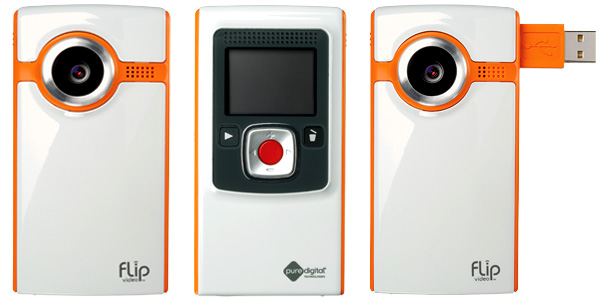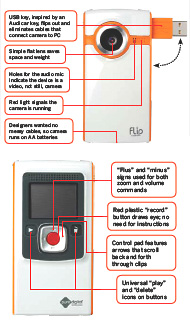Pure Digital Flips the Script
How the Flip—a bare-bones digital camcorder—grew from a simple idea to a contender among giants like Sony

http://www.ebuzz.co.kr/content/buzz_view.html?ps_ccid=58633에서 퍼온 글
동영상이 새로운 소통과 공유, 문화와 표현의 수단으로 갈수록 각광을 받고 있다. 디지털 기술과 인터넷의 발전 덕분이다. 헤아릴 수 없을 만큼 많은 수의 블로그나 동영상 공유 사이트가 인터넷 속에 둥지를 틀면서 일어난 변화다.
누군가의 소소한 일상이나 독특한 생각이 담긴 동영상 한 자락이 세상을 울고 웃게 만드는 것은 이미 새삼스러울 것이 없다. 불과 몇 시간 만에 이름 없는 평범한 사람을 스타로 바꾸어 놓기도 한다. 지구촌 곳곳에서 일어나는 일들을 싱싱한 영상으로 빠르게 접할 수 있는 것도 그런 변화가 가져다준 또 다른 변화의 일부분이다.
퓨어디지털(theflip.com)의 플립 미노(Flip Mino)와 같은 소형 디지털 캠코더가 끊임없이 세상 속에 모습을 드러내고 있는 것도 그런 이유 때문이다. 휴대성과 사용 편의성에 초점을 맞춘 소형디지털 캠코더에 대한 인기가 점점 높아지고 있는 것도, 그런 트렌드가 적지 않은 사람들에게 공감을 얻고 있는 것과 무관하지 않다.
일초에 30 프레임으로 640×480 화소의 동영상을 촬영해 MPEG4 형식의 AVI 파일로 저장할 수 있는 퓨어디지털의 플립 미노. 2GB 용량의 내장 플래시 메모리에 약 60분 분량의 동영상을 촬영해 저장할 수 있고, 본체에 USB 단자와 동영상 공유 사이트에 동영상을 간편하게 올릴 수 있는 소프트웨어가 탑재되어 있다.(사진:theflip.com)
플립 미노는 똑딱이 디지털 캠코더라고 불러도 좋을 만큼 쉽게 사용할 수 있고, 작고 가벼워 휴대하기 좋은 깜찍한 크기의 소형 디지털 캠코더다. 셔터만 누르면 간편하게 사진을 촬영할 수 있는 흔히 똑딱이라 부르는 콤팩트 디지털 카메라처럼, 부담 없이 사용할 수 있고 저렴한 가격표를 달고 있는 것이 특징이다.
휴대성과 사용 편의성을 높이는 데 중점을 둔 제품인 만큼, 플립 미노의 디자인이나 기능은 지극히 단순하다. 앞면에는 렌즈가 뒷면에는 작은 디스플레이와 몇 개의 조작 버튼이 있을 뿐이다. 그래서 사용 방법을 익히기 위해 시간을 들이거나 설명서를 굳이 볼 필요가 없을 정도로 쉽게 사용할 수 있다.
동영상을 찍고 싶을 때는 가운데 자리 잡은 빨간색의 촬영 버튼을 누르기만 하면 된다. 촬영 버튼 주위에 있는 버튼들은 저장된 동영상을 재생하거나 앞뒤로 이동할 때 사용한다. 특히 전원을 넣고 약 3초만 기다리면 바로 동영상을 촬영할 수 있을 정도로 나쁘지 않은 순발력을 가진 것도 장점이다.
촬영 가능한 동영상의 해상도는 640×480 화소로 눈높은 사용자들에게는 큰 매력을 느끼지 못할 듯하다. 하지만 블로그나 동영상 공유 사이트에 올리고 공유하는 정도로 활용하기에는 무난해 보인다. 동영상은 일초에 30프레임으로 촬영한 후 MPEG4 형식의 AVI 파일로 변환해 내장 메모리에 저장한다.
내장 플래시 메모리의 용량은 2GB로 약 60분 분량의 동영상을 저장하는 것이 가능하다. 특히 본체에 USB 단자가 내장되어 있어서 PC나 노트북의 USB 단자에 꽂기만 하면, 바로 데이터를 옮기거나 내장 배터리를 충전할 수 있는 점도 돋보인다.
또한 본체에 내장되어 있는 소프트웨어를 이용하면 유투브(YouTube), 마이스페이스(MySpace), AOL 비디오 등의 사이트에 촬영한 비디오를 간편하게 업로드 하는 것이 가능하다. 아울러 동영상 메일을 보내고, 촬영한 동영상을 편집할 때도 내장된 소프트웨어를 활용할 수 있다.
줌 기능은 2배의 디지털 줌만을 지원한다. 디스플레이는 해상도가 528×132 화소인 약 38mm(1.5인치) 크기의 컬러 액정을 탑재했다. 메모리에 저장되어 있는 동영상을 TV를 통해 볼 수 있는 TV 출력 기능도 지원한다. 크기는 약 100x50x16mm 무게는 약 93.5이며, 미국에서의 판매 가격은 약 180달러다.
http://www.businessweek.com/magazine/content/08_17/b4081076893508_page_2.htm에서 퍼온글입니다.
It’s hard to imagine that Pure Digital Technologies, the company behind the popular Flip Video camcorder, wanted to design a “shy” product. But that’s how Jonathan Kaplan, chief executive and founder of the San Francisco-based startup, describes the playful, inviting look of the device.
With nearly 1 million Flips sold since the digital camcorder’s May, 2007, debut, and with enthusiastic fans like Oprah and Rosie O’Donnell, Kaplan and his design team seemed to have struck a chord with consumers. In a cutthroat market dominated by global consumer electronics giants such as Sony (SNE), little-known Pure Digital and its 80 employees have changed the game by making a bare-bones, affordable camcorder (starting price: $120 vs. the average $314). To put the number of Flips sold in perspective: About 6 million camcorders were shipped to U.S. retailers in 2007, according to the Arlington (Va.)-based Consumer Electronics Assn. Getting close to the 1 million mark in less than a year is impressive for a new product in this category, says CEA economist Shawn Dubravac. “Before, companies flaunted technical features for nerds and geeks, but consumers are responding to the Flip’s convenience and price.”
For years, the behemoths have been racing toward designing ever-more-complex video cameras. Then along came the Flip, daring to compromise video quality to offer a cheaper, simpler device. Its images lack the crisp resolution offered by big-name cameras. So should the likes of Sony and Panasonic be worried? Maybe: During the tough 2007 Christmas shopping season, Flip camcorders dominated the top five spots on Amazon.com’ (AMZN)s list of most-popular digital video cameras. Kaplan says revenues have jumped 300% in the last year, though privately-held Pure Digital doesn’t disclose sales figures. So how did this obscure upstart with no name recognition charm so many fans with a low-tech camcorder with subpar images?
Pure Digital began in 2001 as a maker of throwaway digital cameras for both still pictures and video. The cameras were sold in drugstores and required users to have their images processed on the premises or at a designated digital-photo lab. Buyers started offering unsolicited feedback. “They wanted a more permanent, shoot-and-share video camera that was fun and easy to use,” Kaplan says. He paid attention, and created a product for them—without hiring focus groups.
SOAP-BAR SIMPLE

Timed to tap the craze of homegrown videos posted on blogs and YouTube (GOOG), the Flip made it easier for users to become amateur filmmakers. It’s a no-frills camera the size of a bar of soap—without cumbersome cables that connect to PCs (“A Sweet and Simple Camcorder“, BusinessWeek, 6/04/07).
Kaplan gave his designers a broad goal: strip away all control buttons and features from a typical camcorder and add back only the essentials. They began by eliminating the slot found on many digital cameras for extra memory cards needed to store lots of images. Instead, the Flip offers internal storage from a half hour to an hour, depending on the model. They replaced multiple controls with a simple series of buttons. The hardest part was replacing the unwieldy USB cables and chargers that come with most digital camcorders. First the team tried retracting power cables. But that didn’t eliminate cords, which can tangle or get lost. Instead, they chose cheap AA batteries to power the Flip—so there’s no need for a clunky plug or AC adapter.
Pure Digital’s solution to the messy cables often needed to attach a camcorder to a PC to upload files is a design breakthrough: the flip-out USB key. And it became the Flip’s brand symbol. Kaplan’s inspiration came not from Silicon Valley but from Detroit—from the key to his Audi.
The car key is concealed in a plastic case until the driver presses a button, causing it to shoot out like a switchblade.
Similarly, the camcorder’s USB key is hidden on the side until a button is pushed and it flies out. Users plug it into the USB port of a PC or laptop to quickly transfer their video to a hard drive, and then post clips online. To begin editing or storing video, users don’t need CDs to install software on their hard drives when they buy the camera. Its built-in software (compatible with Macs, too) loads instantly each time the device is plugged into any computer.
LIMITED EDITING
Pure Digital pushes new products to market quickly. In September, 2007, four months after its first release, it began selling the smaller Flip Video Ultra in 20,000 stores, including Wal-Mart (WMT), Costco (CSCO), and Best Buy (BBY). Prices are modest: $150 for the 30-minute version of the Ultra, in basic stark white or black, and $180 for the 60-minute one, also available in orange and pink. And to drive consumers to certain stores to buy a particular color, almost like collector’s items, some camera colors are exclusive to their retail outlet.
Still, the Flip has flaws. And Kaplan is quick to agree: “O.K., so we don’t have the highest-quality components or expensive paints.” But those compromises helped Pure Digital keep its own manufacturing and consumer prices down—a helpful lesson for companies looking to save money for themselves and their clientele in a recession.
Critics point to the cameras’ simple software, which doesn’t offer such features as the ability to add fancy, Hollywood-style titles and scene transitions. To this, Kaplan says, hey—it’s a camera and software bought together for less than $200.
“We hear the challenges, but we don’t want the software to become more complex,” he says. “We want to have software that helps users feel smarter.”
Kaplan’s position is counterintuitive, just as the Flip’s success is. He says Pure Digital is looking for new niches, working on even tinier models—and possibly other devices that feature some of the Flip’s user-friendly elements. The small startup that shrank the camcorder is now challenging the big players—in a way that’s anything but shy.
Return to Inside Innovation Table of Contents
Jana is the Innovation Dept. editor for BusinessWeek.

